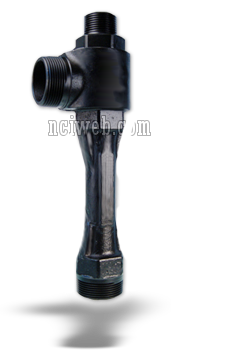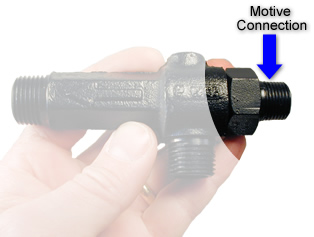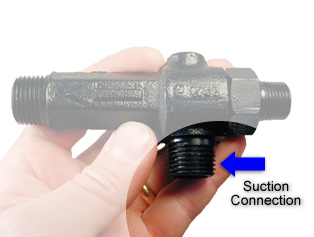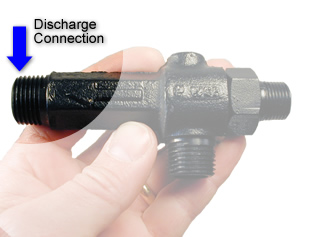Gas Eductors
 Our eductor models for liquids pumping gases are Model(s) ML & MLE. For gases pumping gases: Model(s) SG & HG. These models can be used for both exhausting and evacuation.
Our eductor models for liquids pumping gases are Model(s) ML & MLE. For gases pumping gases: Model(s) SG & HG. These models can be used for both exhausting and evacuation.
Exhausting: This application involves removing gases at a continuous rate from an area while maintaining the pressure at a stable level. These applications often involve removing gases or fumes that are continuously recurring. An example would be removing smoke from a welding or machining area. This process also could be used for injecting oxygen into a liquid stream. If the gases being removed have undesirable characteristics, it is possible in some cases to neutralize them by using a reactive motive fluid.
Evacuation: This application involves pulling gases (using jet pumps) from a defined volume by pumping the tank down from a starting pressure to a final lower pressure. It is generally sized by determining the amount of time it takes to reduce the pressure in the vessel to the desired final pressure. Examples of this application would be reducing the pressure in a reaction vessel to purge it of detrimental gases, or removing steam from a vessel before opening it to increase operator safety. A variation of this type of application is the use of eductors to prime piping or a system with liquid. Priming evacuations may be used to bring the level of liquid up to pump level to avoid the pump being started dry or to establish a syphon.
Other models of eductors are available for specific applications. In some cases, these specialty eductors can pump a suction volume up to 50 times the motive volume. Most jet pumps are available in sizes from 1/2" through 3" in a wide variety of materials.Expedited deliveries are possible if needed. Units are available in sizes up to 12".
Eductors operate on the basic principles of flow dynamics. This involves taking a high pressure motive stream and accelerating it through a tapered nozzle to increase the velocity of the fluid. Gas Motives are compressible fluids and are put through a converging-diverging nozzle. The gas can exceed the speed of sound. This fluid is then carried on through a secondary chamber where the friction between the molecules of it and a secondary gas (generally referred to as the suction fluid) causes this secondary gas to be pumped. These fluids are intimately mixed together and discharged from the eductor.
Eductors Specifications
There are three connections common to all venturi eductors

- Performance Table
- Motive Connection
- Suction Connection
- Discharge Connection
| General Performance Table | ||||
|---|---|---|---|---|
| Description | Model ML | Model MLE | Model SG | Model HG |
| Motive Media | Liquid | Liquid | Steam, Air | Steam, Air |
| Motive Pressure (PSIG) | 20-250 | 20-250 | 60-120 | 20-80 |
| Maximum Vacuum (in Hg) | 29 | 29 | 24 | 24 |
| Outlet Pressure (PSIG) | 20 | 20 | 12 | 20 |
 Eductor MOTIVE Connection: This connection is where the power for the eductor is generated, by increasing the velocity of the motive fluid. The eductor nozzle in this section takes advantage of the physical properties of the motive fluid. Eductors with liquid motives use a converging nozzle as liquids are not generally compressible. Eductors with gas motives utilize converging-diverging nozzles to achieve maximum benefit from the compressibility of the gas. All eductor nozzles for eductors have smooth flow paths. Flow paths with sudden steps or roughness on these high velocity surfaces cause jet pumps to operate less efficiently.
Eductor MOTIVE Connection: This connection is where the power for the eductor is generated, by increasing the velocity of the motive fluid. The eductor nozzle in this section takes advantage of the physical properties of the motive fluid. Eductors with liquid motives use a converging nozzle as liquids are not generally compressible. Eductors with gas motives utilize converging-diverging nozzles to achieve maximum benefit from the compressibility of the gas. All eductor nozzles for eductors have smooth flow paths. Flow paths with sudden steps or roughness on these high velocity surfaces cause jet pumps to operate less efficiently. SUCTION Connection: This connection of the eductor is where the pumping action of the eductor takes place. The motive fluid passes through the suction chamber, entraining the suction fluid as it passes. The friction between the fluids causes the chamber to be evacuated. This allows pressure in the suction vessel to push additional fluid into the suction connection of the jet pump. The high velocity of the motive stream in this section of the eductor directs the combined fluids toward the outlet section of the eductor.
SUCTION Connection: This connection of the eductor is where the pumping action of the eductor takes place. The motive fluid passes through the suction chamber, entraining the suction fluid as it passes. The friction between the fluids causes the chamber to be evacuated. This allows pressure in the suction vessel to push additional fluid into the suction connection of the jet pump. The high velocity of the motive stream in this section of the eductor directs the combined fluids toward the outlet section of the eductor. Discharge Connection: As the motive fluid entrains the suction fluid, part of the kinetic energy of the motive fluid is imparted to the suction fluid. This allows the resulting mixture to discharge at an intermediate pressure. The percentage of the motive pressure that can be recovered is dependent upon the ratio of motive flow to suction flow and the amount of suction pressure pulled on the suction port. The mixture then passes through the diverging taper that converts the kinetic energy back to pressure. The combined fluid then leaves the outlet.
Discharge Connection: As the motive fluid entrains the suction fluid, part of the kinetic energy of the motive fluid is imparted to the suction fluid. This allows the resulting mixture to discharge at an intermediate pressure. The percentage of the motive pressure that can be recovered is dependent upon the ratio of motive flow to suction flow and the amount of suction pressure pulled on the suction port. The mixture then passes through the diverging taper that converts the kinetic energy back to pressure. The combined fluid then leaves the outlet.
The Process of Sizing an Eductor
Sizing an eductor is a relatively straight forward process. The following information will help you begin the process. If you wish to have us size an eductor(s) for your application please use one of the "Request Pricing" forms to contact us.
The JRG/JT models SG and HG are general purpose eductors used to pump gas with a gas as the motive stream. They can be used to pull both liquid and gas suction loads. In this case, we will deal with gas suction stream applications. The model SG is generally used with higher pressure motive flows in the ranges of 60 to 120 PSIG. It is possible to use lower pressures with these units if the outlet pressures are strictly controlled.
The JRG/JT models SG and HG are general purpose eductors used to pump gas with a gas as the motive stream. They can be used to pull both liquid and gas suction loads. In this case, we will deal with gas suction stream applications. The model SG is generally used with higher pressure motive flows in the ranges of 60 to 120 PSIG. It is possible to use lower pressures with these units if the outlet pressures are strictly controlled.
Net Positive Suction Head (NPSH) is one of the most used terms for pumps (including eductors) and also one of the least understood. Simply stated, NPSH is a method of evaluating a set of suction conditions for a pump. This formula takes into account variables for the particular liquid being pumped and the conditions under which it is being pumped. It corrects them to a set of standard conditions.
Click Here for More Informationread more ....
Liquid pumping liquids performance tables.
World Class Distribution Speeds Delivery of Our Eductors
Total customer satisfaction comes from the combination of quality products purchased at a reasonable price and delivery quickly and when promised.
